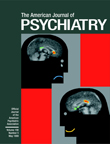Addition of Naltrexone to Fluoxetine in the Treatment of Binge Eating Disorder
Ms. A was a 16-year-old girl who was hospitalized because of binge eating disorder with a complete loss of control of food intake and a severe major depressive episode including suicidal ideation and self-harming behavior (cutting herself). At hospitalization, her weight was 57.6 kg. Binges occurred at least once a day, and the amount of calories per day was about 5,000. Given the evidence that fluoxetine may be effective in reducing weight, Ms. A was treated with a regimen of fluoxetine, up to 60 mg/day, cognitive behavioral therapy, and dietary management. After several weeks, the depressive symptoms improved, but episodes of bingeing remained unchanged. Thus, we decided to administer, in addition to the described treatment schedule, the opiate antagonist naltrexone, at a daily dose of 100 mg. Within 14 days, we found a robust reduction in binge frequency and the amount of food consumed by Ms. A and weight loss. After discharge, Ms. A was treated with a regimen of fluoxetine (at 60 mg/day), naltrexone (at 100 mg/day), and psychotherapy. Follow-up data after 1 year showed that Ms. A’s weight (49 kg) had remained stable, and she never reported more than 2 binges/month. No side effects were documented. After 1 year, the daily dose of naltrexone was reduced to 50 mg/day, which was followed within 2 weeks by an increase in binge frequency. When we increased the dose of naltrexone to 100 mg/day, the symptoms disappeared again.
References
Information & Authors
Information
Published In
History
Authors
Metrics & Citations
Metrics
Citations
Export Citations
If you have the appropriate software installed, you can download article citation data to the citation manager of your choice. Simply select your manager software from the list below and click Download.
For more information or tips please see 'Downloading to a citation manager' in the Help menu.
View Options
View options
PDF/EPUB
View PDF/EPUBGet Access
Login options
Already a subscriber? Access your subscription through your login credentials or your institution for full access to this article.
Personal login Institutional Login Open Athens loginNot a subscriber?
PsychiatryOnline subscription options offer access to the DSM-5-TR® library, books, journals, CME, and patient resources. This all-in-one virtual library provides psychiatrists and mental health professionals with key resources for diagnosis, treatment, research, and professional development.
Need more help? PsychiatryOnline Customer Service may be reached by emailing [email protected] or by calling 800-368-5777 (in the U.S.) or 703-907-7322 (outside the U.S.).

